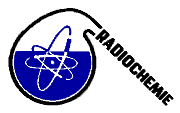Presentation materials
There are no materials yet.
Mr
OLANREWAJU ANJOLAIYA
(LOUGHBOROUGH UNIVERSITY)
22/04/2010, 05:00
Radionuclides in the Environment, Radioecology
Verbal
The aim of this study is to use predictive modelling to understand and calculate the sorption behaviour of radionuclide contaminants in complex environments such as clay-based soils. The effects of Natural Organic Matter (NOM) on the Cation Exchange Capacities (CEC) of different characterised clay soils (St Bees & Mercia Mudstones, Boom clay & London clay) and their constituent clay minerals...
Ms
Bianca Raditzky
(Forschungszentrum Dresden-Rossendorf, Institute of Radiochemitry)
22/04/2010, 05:15
Radionuclides in the Environment, Radioecology
Verbal
The long-term safety assessment of nuclear waste disposals requires detailed knowledge of the transport and interaction behavior of actinides within the technical, geotechnical and geological barriers. In the case of accidental release of radionuclides into the surrounding environment, their migration behavior can be effectively influenced by the ambient conditions like pH, temperature, ionic...
Mrs
Olga Zhukova
(Institute of global climate and ecology)
22/04/2010, 05:30
Radionuclides in the Environment, Radioecology
Verbal
Peculiarity of vertical migration of Cs-137 was investigated in zones of Chernobyl contamination (Bryanskaya, Orlovskaya, Tulskaya and Kaluzhskaya districts). Vertical distribution of Cs-137 on inviolate places characterizing by minimal penetration of peak of maximal concentration for the depth about 2-4 cm in dependence of type of soil and intensity of processes of byoturbation....
Dr
Harald Foerstendorf
(Forschungszentrum Dresden-Rossendorf, Institute of Radiochemistry)
22/04/2010, 05:45
Radionuclides in the Environment, Radioecology
Verbal
The migration behaviour of actinide ions in the geosphere is generally influenced by sorption processes in aqueous media. These processes occurring at solid/liquid interfaces can be monitored by in situ Attenuated Total Reflection Fourier-transform Infrared (ATR FT-IR) spectroscopy providing structural information on a molecular level.[1]
In this work, the sorption of neptunium(V) onto metal...
Mr
Marko Černe
(Jožef Stefan Institute)
22/04/2010, 06:00
Radionuclides in the Environment, Radioecology
Verbal
ABSTRACT
Transfer of radionuclides into the environment is a common phenomenon and due to its potential harmful effect of particular scientific interest in the vicinity of uranium mines. Radionuclides, especially uranium and thorium decay products are discharged with U-mill tailings into the soil and water and consequently into vegetation where they accumulate. Radionuclide soil-to...
Dr
Štefan Palágyi
(Nuclear Research Institute Řež plc)
22/04/2010, 06:15
Radionuclides in the Environment, Radioecology
Verbal
Transport of 125I-, 137Cs+ and 85Sr2+ radionuclides in crushed granitoidic rocks and homogenized soil was studied. Two simple methods for calculation of transport parameters of these radionuclides in flow column experiments with groundwater (GW) as transport medium have been described. The first method is based on the assumption...
Previous tabNext tab
Print
PDF
Full screen
Detailed view
Filter
05:00
06:00
Mr OLANREWAJU ANJOLAIYA
Sorption behaviour of contaminants in soils: pH and humic acid effects on sorption of on CEC of clay soils and minerals, and the mobility of Cd, Cs, Ni and Sr.
Mirror Hall, Casino Conference Centre
05:00 - 05:15
Ms Bianca Raditzky
Complexation of U(VI) with nitrogen and phosphorous containing ligands in aqueous solution
Mirror Hall, Casino Conference Centre
05:15 - 05:30
Mrs Olga Zhukova
Vertical and horizontal distribution of <sup>137</sup>Cs in zone of Chernobyl contamination in Russia
Mirror Hall, Casino Conference Centre
05:30 - 05:45
Dr Harald Foerstendorf
The sorption processes of Np(V) and U(VI) onto metal oxide phases. The formation of sorption complexes and mechanistic aspects studied by in situ ATR FT-IR spectroscopy
Mirror Hall, Casino Conference Centre
05:45 - 06:00
Updating the timetable...

